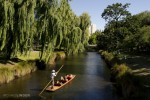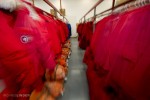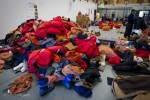Sights and Sounds of Summer in the South
It’s January 17th, and we’re in Christchurch, New Zealand—about as far south of the equator as Rutgers is north of it. If you were holding a globe in your hands and looking at New Jersey, Christchurch would be all the way around the other side, near your pinky fingers.
All that you’ve learned about the Southern Hemisphere gets put into practice here: Early January is midsummer and we’re sweating in 90 degree heat. Cicadas are humming, birds are hopping around the lawns feeding newly fledged chicks, and gardens are in full bloom. If you watched a sundial, you’d see the shadow move counterclockwise instead of clockwise, and the sun is always off to the north of us.
Despite the heat, we spent the afternoon diving into our Extreme Cold Weather gear. Tomorrow we’ll be at 77 degrees south, where midsummer heat means 32 Fahrenheit, not 32 Celsius. By mid-February, when the expedition ends, it could be a lot colder than that—so we better make sure our gear fits.
- The summer sun makes the flowers in the Christchurch Botanic Gardens burst with color. All around, the trees ring with songs of greenfinches, chaffinches, and bellbirds.
- Tourists on summer holidays take rides in shallow-bottomed punting boats, pushed along (punted) by young men using long poles. Enormous weeping willows line the river banks, offering cool shade. We’re enjoying the smells of summer before we leave it behind for the black-and-white, ice-and-rock of Antarctica.
- Each summer, about 3,200 people go to McMurdo Station, Antarctica, and they all come through the Clothing Distribution Center to make sure they have enough warm clothes. One of the key items is Big Red—a thick parka that will help fend off the cold Antarctic weather. It’s so big that you can’t tell who’s inside it—so everyone gets a white velcro chest patch with their name on it.
- About 50 people were getting outfitted for the next flight to the ice. One man had brought along his two little dogs, though they won’t be coming along with us. There are no canine Big Red parkas, and only humans are allowed on the plane (and on the continent).
- The night before, a big C-17 jet had brought back a load of scientists. This is the gear they had with them. The clothing center staff will sort through, clean, mend, fold, and reorganize all of this gear for more visitors to use next year. In the background, we’re going through our gear to make sure everything fits and we have what we need: thick rubber gloves for handling wet oceanographic equipment, soft fleece gloves, wool mittens, white waterproof ‘bunny boots’ to keep our feet from getting frostbitten, tough wind pants, thick long underwear, three kinds of hats, and a pair of goggles for seeing in storms.
- The staff of the Clothing Distribution Center, like everyone we’ve met in the U.S. Antarctic Program, are cheerful, skilled, and helpful. Ashley Needham helped me get the extra-thick kind of wind pants and an oversize windbreaker to help keep me warm and happy on the deck of the icebreaker. He’s a New Zealander, a builder by trade, and works seasonally for the CDC. He’s collecting quarters from all 50 U.S. states from coins people leave behind in their pockets. (I gave him Virginia).
- This is the top layer of a 6-foot-high, 378-pound crate of dirty socks. Keeping the vast amounts of gear clean, organized, and serviceable is a major job, especially when February comes and the summer staff of McMurdo all come back at once. Upstairs in the storage area, I counted 700 boxes of clean thermal underwear (‘underdrawers’ as the New Zealanders call them), just waiting for people like us.
- We spent the evening packing our bags. Most of our gear will be loaded onto pallets and we won’t see it until we arrive in McMurdo. We get to keep one bag in case bad weather sets in after takeoff and it’s too dangerous to land in Antarctica. In that case, our plane ‘boomerangs’—turns around at the halfway point and comes back to Christchurch. Everyone dreads getting a boomerang flight, but it’s better than the alternative of trying to land a 260-ton plane in a blizzard.
As it turned out, we didn’t even get to take off, but it was because the weather has been too warm, not too cold. There’s no flat ground around McMurdo Station, so planes land on runways made on the sea ice. Recent above-freezing temperatures in McMurdo had left the ice slushy, wet, and too dangerous to attempt landing such a large plane. In a strange twist from normal, we’re actually going to wait until the coldest part of the day and hope that the runway ices up before we try to land. We’ll be taking off at 11 p.m. tonight and landing around 4 in the morning.
Soon after we arrive we’ll board our ship, the Nathaniel B. Palmer, where the expedition scientists will be hard at work getting their equipment installed so that we can get under way.
For now, we’ll soak up as much summer as we can. Here’s a recording to give you a sense of what it’s like to fly into New Zealand and emerge into the middle of summer. Listen closely, and you’ll hear a flight attendants’ greeting (in a pleasant New Zealand accent), a Christchurch tram heading into town, a group of Japanese taiko drummers giving an exhibition in the town square, a cicada with an incredible sense of rhythm, and the sweet, haphazard song of a bellbird, which is common in New Zealand but lives nowhere else in the world.
[audio:https://coseenow.net/ross-sea//2011/01/Sounds-of-summer-New-Zealand_1-2.mp3]
Download mp3
And for teachers, you may be interested in exploring this map of the Ross Sea expedition of 1841. Almost exactly 160 years ago, Captain James Clark Ross explored this area in two 100-foot sailing boats—an incredible adventure that seems almost impossible by today’s standards. The map includes excerpts from Captain Ross’s journals and offers another way for you to get to know the Ross Sea. In a few days, we’ll be sailing these exact same waters.
We encourage you to follow us on Facebook—you’ll get notified when new posts are up, and you’ll see extra updates and photos from Chris and me during the day.


 January 16, 2011
January 16, 2011 















5 Responses to “Sights and Sounds of Summer in the South”